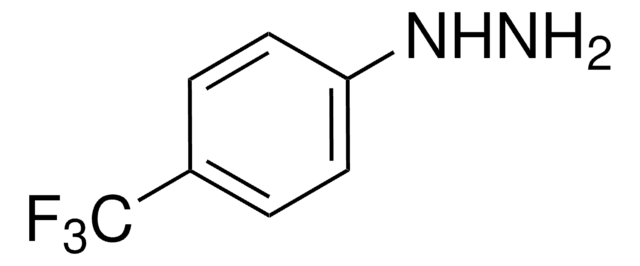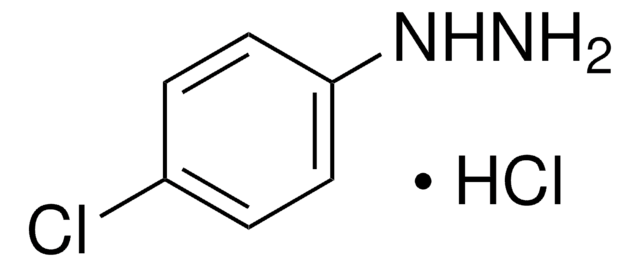P26252
Phenylhydrazine
97%
Synonym(s):
Hydrazinobenzene, Monophenylhydrazine
About This Item
Recommended Products
vapor density
4.3 (vs air)
Quality Level
vapor pressure
<0.1 mmHg ( 20 °C)
Assay
97%
autoignition temp.
345 °F
refractive index
n20/D 1.607 (lit.)
bp
238-241 °C (lit.)
mp
18-21 °C (lit.)
density
1.098 g/mL at 25 °C (lit.)
SMILES string
NNc1ccccc1
InChI
1S/C6H8N2/c7-8-6-4-2-1-3-5-6/h1-5,8H,7H2
InChI key
HKOOXMFOFWEVGF-UHFFFAOYSA-N
Looking for similar products? Visit Product Comparison Guide
Application
- 4, 4′-(arylmethylene)-bis(3-methyl-1-phenyl-1H-pyrazol-5-ol)s by reacting with aryl aldehydes and acetoacetates in presence of N-bromo sulfonamide as a catalyst via one-pot pseudo-five-component condensation.
- Thiazolidinones by treating with mercaptoacetic acid and aldehydes or ketones.
- 5-[3,3,3-trifluoro-2-(phenylhydrazono)propyl]-1-phenyl-1H-pyrazole-3-carboxylic acid by reacting with 6-(trifluoromethyl)comanic acid.
It can be also used as a precursor for the preparation of selective carboxymethylated products at N-1 and N-2 by reacting with dimethyl carbonate (DMC) in the presence of a Bronsted base and metal salts as a catalyst.
Signal Word
Danger
Hazard Statements
Precautionary Statements
Hazard Classifications
Acute Tox. 3 Dermal - Acute Tox. 3 Inhalation - Acute Tox. 3 Oral - Aquatic Acute 1 - Carc. 1B - Eye Irrit. 2 - Muta. 2 - Skin Irrit. 2 - Skin Sens. 1 - STOT RE 1
Storage Class Code
6.1A - Combustible, acute toxic Cat. 1 and 2 / very toxic hazardous materials
WGK
WGK 3
Flash Point(F)
192.2 °F - closed cup
Flash Point(C)
89 °C - closed cup
Personal Protective Equipment
Regulatory Listings
Regulatory Listings are mainly provided for chemical products. Only limited information can be provided here for non-chemical products. No entry means none of the components are listed. It is the user’s obligation to ensure the safe and legal use of the product.
EU REACH Annex XVII (Restriction List)
Certificates of Analysis (COA)
Search for Certificates of Analysis (COA) by entering the products Lot/Batch Number. Lot and Batch Numbers can be found on a product’s label following the words ‘Lot’ or ‘Batch’.
Already Own This Product?
Find documentation for the products that you have recently purchased in the Document Library.
Customers Also Viewed
Articles
Glycans play a key role in protein structure and disease; representation on cell surfaces is the glycome.
Our team of scientists has experience in all areas of research including Life Science, Material Science, Chemical Synthesis, Chromatography, Analytical and many others.
Contact Technical Service













